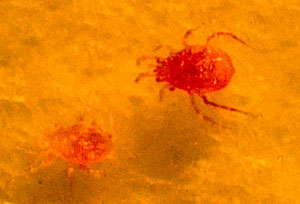Mites

Mites are more closely related to spiders than they are to insects. Mites do not have antennae like insects do, or segmented bodies or wings. They are usually very small and often go unnoticed. Most mites have an egg stage, a six-legged larval stage, and two eight-legged stages before becoming an adult. Phytoseiid mites are the major group of natural enemies that attack certain kinds of pest spider mites. It is especially important to conserve predatory mites in the landscape to prevent pest mite outbreaks. Other insect pests are also eaten by predatory mites including whiteflies, thrips, and certain insect eggs.
Most predaceous mites are somewhat pear-shaped and shiny, with noticeably long legs. They may be bright red, yellow, or green depending on what they've been eating and appear "see-through". Predaceous mite eggs are usually oblong instead of spherical like the eggs of pest mite species. Predaceous mites are also much more active and mobile than pest mite species.
